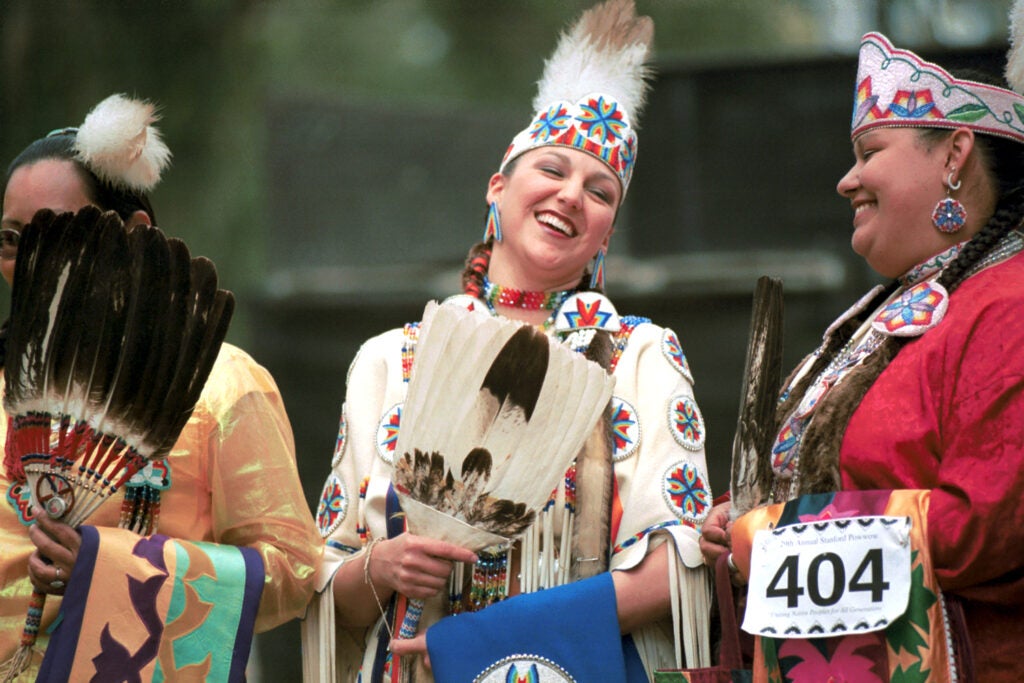‘We’re still here’: Student-led Stanford Powwow returns as an in-person event
Thousands of attendees including dancers, singers, and artists from hundreds of tribes, nations, and communities are expected on campus this weekend at the 51st Stanford Powwow.
When sophomore Ryan Duncan, a member of Choctaw Nation and Chickasaw Nation, enters a powwow, the drum greets him with a warm embrace. Each beat is a reminder that he’s a part of something larger than himself.

Hope Kimple of Alameda (center) shares a laugh with Felicia Gallegos of Denver (right) during the 2000 Stanford Powwow. (Image credit: L.A. Cicero)
Ba-dum. Here, you are in community.
Ba-dum. Here, we celebrate.
Ba-dum. Here, we honor resilience.
Ba-dum. Here, you are home.
This weekend, the 51st Stanford Powwow, the largest student-led event of its kind, returns as an in-person event with hundreds of tribes from around the nation and thousands of attendees expected to join over the three days.
First hosted in 1971 by the Stanford American Indian Organization to offset the negative image of the university’s Indian mascot at the time, the Stanford Powwow is a celebration of the diverse Native American and Indigenous cultures on campus. It brings together dancers, singers, and artists from hundreds of tribes across the United States and Canada.
For Grace Carter, a sophomore and Cherokee from Cherokee Nation, powwows, whether at Stanford or back home in Oklahoma, are a celebration – a time to connect with family and honor community.
“Growing up, the powwow for my tribe was an intertribal powwow and Grand Entry is one of my most salient memories … everyone coming in together and seeing regalia from different tribes, it’s very inspiring,” Carter said.
This year’s theme is “Intergenerational Resilience,” a phrase chosen by the 40 students who begin planning over several months under Carter and Duncan’s leadership.
“For me, intergenerational resilience is about honoring the fact that we have been here for 50-plus years and coming out of the pandemic after being virtual for two years. We’re really trying to celebrate the resilience of our community,” Carter said. “We also wanted to incorporate honoring our elders. There’s been so much in the news about boarding schools and finding mass graves; we want to honor our ancestors and celebrate that we’re still here.”
A chance to connect
For Carter and Duncan, the powwow is also an opportunity to explore the intersection of their identities as Native Americans and Stanford students. Growing up in Missouri and Oklahoma, respectively, both attended powwows with family on the weekends but say they didn’t always connect with their Native identities day-to-day.
But at Stanford, home to more than 450 Native and Indigenous-identifying students, both students have found a robust and active community.
“Growing up, my Native identity was always conflicted between white spaces and non-white spaces … it wasn’t that I suppressed my Native identity, it was that it didn’t need to come up, and there weren’t organizations for me to embrace it,” Duncan said. “But as I’ve become more comfortable with myself and my expression of my identity, it’s become more of a focus for me and something I’m proud to display and want people to know about me.”
Carter, who plans to study tribal law at Stanford, wants to return to Cherokee Nation after graduation.
“In high school, I started to think about what community I want to live in [after college], and my Cherokee community came up as a welcoming community that could benefit from strong lawyers and strong policy work,” Carter said. “Coming to Stanford, I realized we have a very good tribal law and federal Indian law program, which is unique, especially for a top law school. It just felt like a confirmation that this was the right place.”
Duncan plans on majoring in Native American studies and minoring in education and wants to explore the possibilities of language revitalization for early childhood education.
“I want to decolonize western spaces like education and create an educational space that values Native languages and culture in addition to teaching standard core curriculum,” he said.
‘A great display of community’
Though a slightly smaller event this year than in pre-pandemic years, the Stanford Powwow is still expected to draw upwards of 10,000 attendees and will include a market featuring nearly 100 food, craft, and informational vendors.
Duncan said he encourages people who have never been to a powwow or immersed in Native or Indigenous culture to approach the weekend open-minded and as an opportunity to learn about the diversity and pride within the community.
“Powwow is a great display of community and proudness in our culture,” he said. “Because it’s intertribal and a community event, it thrives off different experiences. There’s a lot of laughter and joy going around, so I think it’s a very safe way for people to learn about Native people directly from Native people and in their own words.”
More information about the Stanford Powwow and a schedule of events is available online.